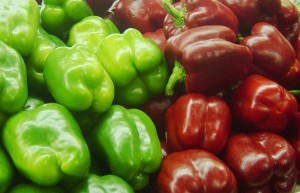 You need fresh produce in your diet. Many of the vitamins, minerals, and phytochemicals keep your body healthy, growing, and healing. The vital nutrients in fruits and vegetables help you ward off heart disease, stroke, and even vision loss. A produce-rich diet also lowers blood pressure and cholesterol, and helps you maintain a healthy weight.
You need fresh produce in your diet. Many of the vitamins, minerals, and phytochemicals keep your body healthy, growing, and healing. The vital nutrients in fruits and vegetables help you ward off heart disease, stroke, and even vision loss. A produce-rich diet also lowers blood pressure and cholesterol, and helps you maintain a healthy weight.
Eating produce is important. But what about buying it? How much do you know about what to buy and how to find the freshest of the fresh vegetables and fruits?
After reading this post, you’ll have a (lettuce) head’s up on produce shopping habits.
General Produce Buying
Stay clear of anything damaged or bruised; however, a small bruise or dent is okay. Fruits and vegetables are just like us — a little flaw here and there doesn’t mean we’re bad apples!
Another general tip is to choose items surrounded by or near ice if it’s freshly cut, such as half a watermelon or seasonal vegetables. The ice cold temperature maintains the freshness of the produce.
Another tip: bag your fruits and vegetables separately from meat, poultry, and seafood. These foods have different expiration dates and contaminants, and you don’t want them mixed up.
Lastly: buy fruits and vegetables when they’re in season so you can take advantage of lower prices. If you have access to a local farmers’ market, you should go! The foods are fresher and you’ll find more variations in what to buy.
5 Specific Produce Tips
Now, let’s get into some more specific tips for buying produce:
- Apples: Fresh apples have firm skin. Test the firmness of the apple by balancing on the palm of your hand. The heavier it feels, the healthier the apple! If it feels soft and light, it’s not a good apple. Store your apples in a cool dark place or in a bag in your fridge.
- Blueberries: Look for blueberries plump in size and color that have a firm look. If the blueberries look withered or dull colored, they are going bad. When storing blueberries, throw out the bad ones first. Store in your fridge and don’t wash them until it’s time to eat.
- Broccoli: Good broccoli is dark green to almost blue in color on the flowers with small buds. Avoid limp broccoli with soft flowered ends. Keep broccoli in your fridge in a plastic bag, unwashed until it’s time to use it.
- Carrots: Quality carrots are smooth and firm. Look for carrots straight in shape with no blemishes, too. The deeper the orange color, the better the carrots’ nutritional content. Store carrots in a plastic bag away from fruits. Remove the leafy top and loose dirt before storing.
- Tomatoes: Like most fruits and vegetables, look for firm skin and little to no discoloration. Also look for slightly pink coloring. Tomatoes that are partially green will ripen if left out in the open for a day or two. Avoid soft tomatoes or tomatoes with wrinkled skin. Store in a cool place away from the sun. Store sliced tomatoes in the refrigerator.
Now that you’re a little savvier about buying fresh produce, here’s how to prepare your purchases:
Produce Preparation Tips
- Keep your vegetable bins as clean as possible. Fragments of old fruit or vegetables may attract germs and other unwanted bacteria.
- Rinse fruits and vegetables before eating, but not before storage.
- Do not use soaps, detergents or other cleaning solutions on your produce.
- Before washing or cutting produce, wash your hands and utensils with warm water.
- Use a vegetable brush under running water to clean tougher-skinned produce like potatoes, carrots, and melons.
- Wash large amounts of leafy greens by placing them in a water-filled sink. Let them fully soak and let the dirt and other sediments fall off. Then, drain the water and re-wash each leafy green again.
- Do not store bruised items. Instead, cut off the damaged area. If the area has spread to most of the fruit, discard it completely.
- Always dry your fruits and vegetables before storing. Damp, cool, and dark places are where bacteria thrive.
Got a produce tip to share? Leave it below!
Photo Credit: Martin LaBar





